With mesmerizing history and some of the most beautiful national parks, these incredible things to do in Kanchanaburi Thailand make it a traveler’s dream.
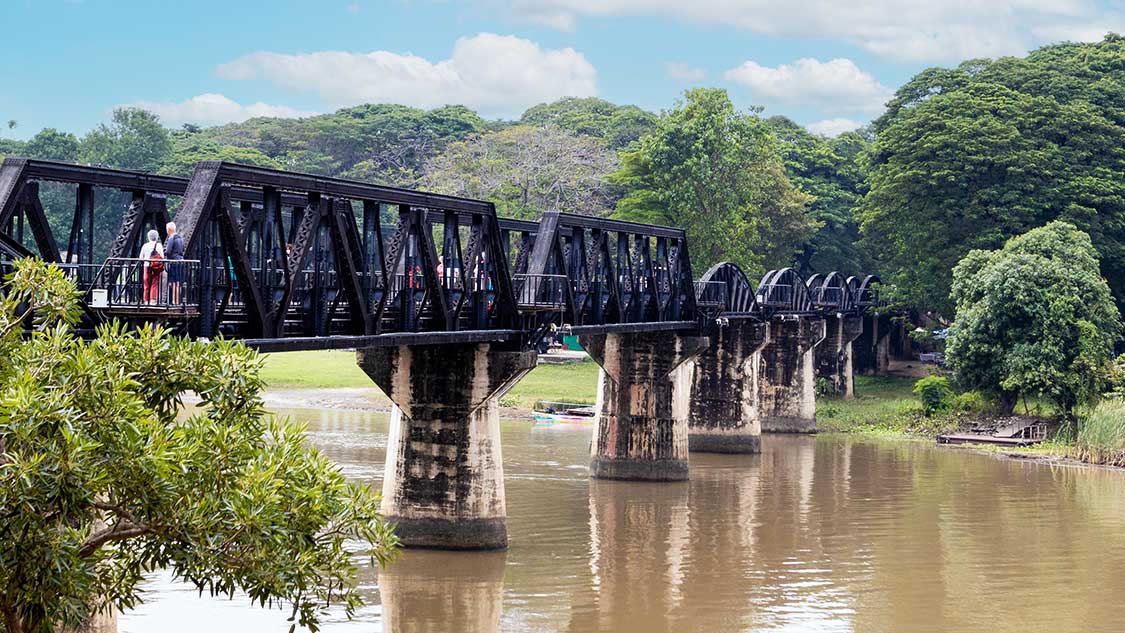
Situated just 80 miles from the city of Bangkok, the Kanchanaburi region is an often overlooked destination for travelers in Thailand.
But as tourism in Thailand continues to grow, more and more visitors are taking the time to explore this under-the-radar destination and discovering that incredible vistas, lush nature, and incredible history are just a drop in the bucket when it comes to the best things to do in Kanchanaburi.
Kanchanaburi covers a large region of central Thailand, and its history is steeped in military strategies and horrors. It rose to prominence in the late 18th century when King Rama I set the city as a defensive outpost to protect against attacks from the neighboring Burmese. This remained its primary function until the early 1900s, when the threat of attack was reduced.
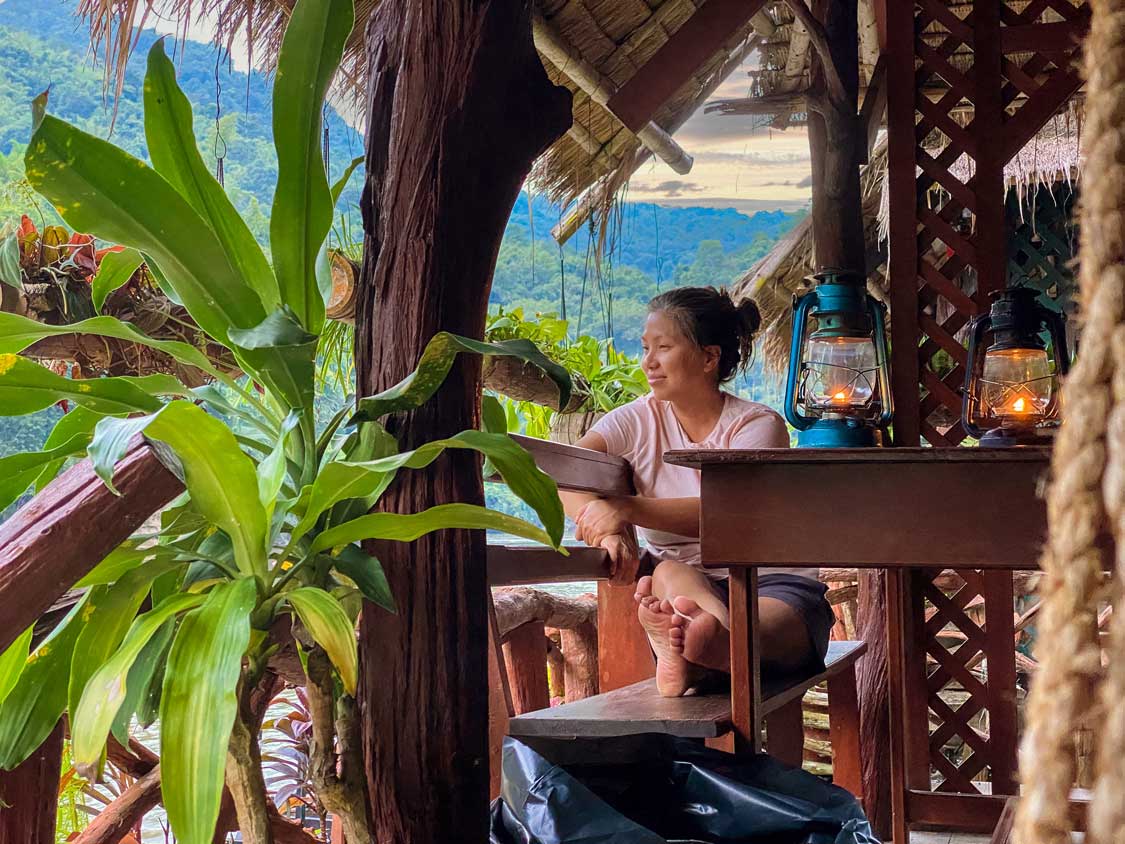
This all changed during the Second World War when the Japanese invaded Thailand and set about creating a railway to move goods from Burma to the shores of the Gulf of Thailand. The Burma Railway, as it was named by the Japanese, was built almost entirely by prisoners of war and slaves captured from China and Southeast Asia.
Over the course of three years, more than 180,000 civilians and over 12,000 POWs were subjected to inhumane working conditions, malnutrition, and disease as they were forced to construct the railway. Of those forced into labor, around 90,000 civilians died, as did more than 12,000 Allied prisoners. This led to the railway being dubbed the “Death Railway.“
Kanchanaburi has since rebounded from the disasters of WWII and is now one of the fastest-growing destinations for tourism in Thailand. It was one of my family’s favorite places to visit in Thailand, and you’ll soon understand why.
The Best Things To Do In Kanchanaburi, Thailand
Table of Contents
Kanchanaburi isn’t lacking in attractions. Although this city might not be as famous as places such as Bangkok, Phuket, or Chiang Mai, Kanchanaburi offers a wealth of experiences in a much more relaxed package than its more popular siblings.
Walk Over the Bridge on the River Kwai
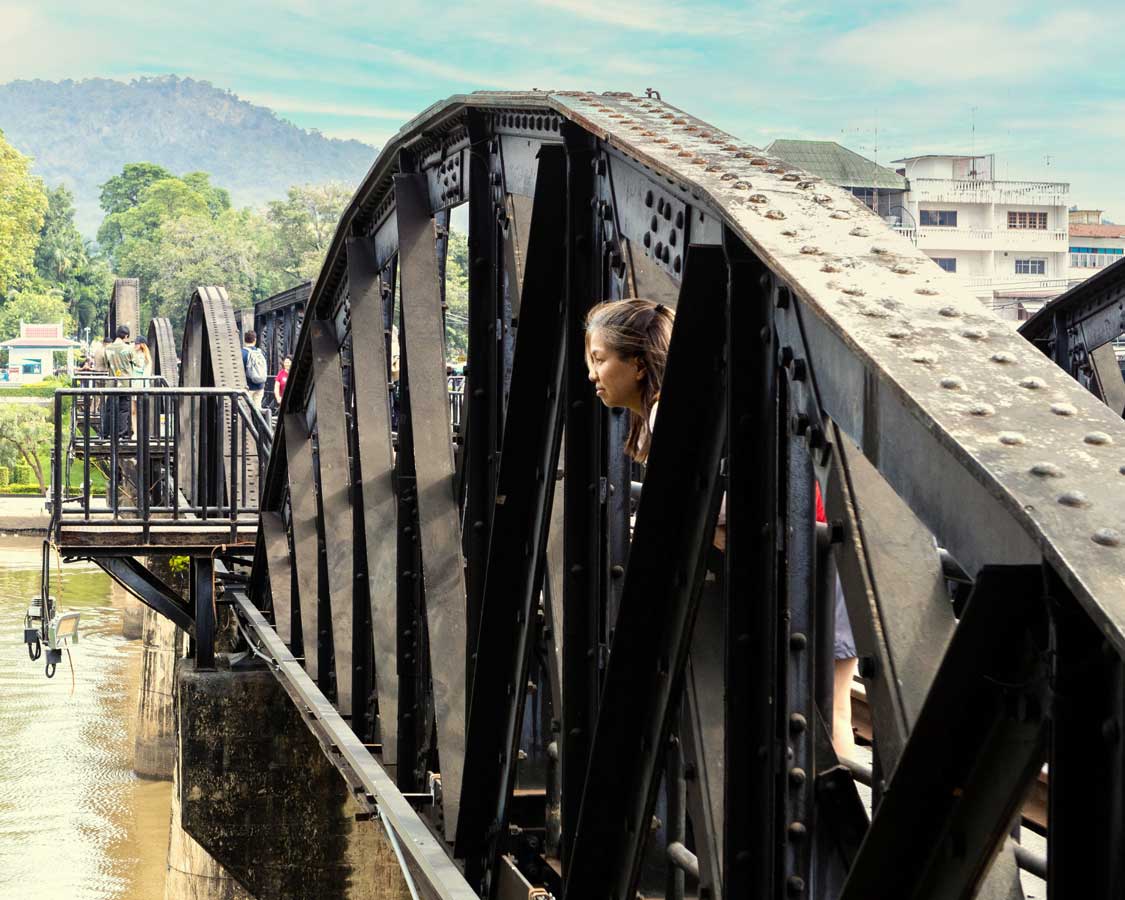
Among the most famous of all of the places to visit in Kanchanaburi is the Bridge on the River Kwai, otherwise known as the Death Railway Bridge.
The Bridge on the River Kwai is the biggest symbol of the tragedy of the Burma Railway, but you’d never know that by simply visiting. The Thai people have a tremendous ability to look on the bright side of every situation. Rather than a memorial, the atmosphere around the Death Railway Bridge is downright festive.
The bridge was built between 1942 and 1943 as the only steel bridge the Japanese commissioned during the war. It was infamously bombed again and again by Allied troops attempting to disrupt the movement of goods between Burma and Japan.
The bridge was relatively innocuous until the release of the Hollywood blockbuster ‘Bridge on the River Kwai’ starring William Holden and Sir Alec Guinness. The popularity of the film introduced a new passion to the story that inspired it, and today, the bridge acts as a reminder of the history and horrors of war.
Each day hundreds of visitor walk, hop, or cycle over the bridge. You can even hop on the train from the nearby station and ride it all the way to Bangkok.
Visit the Kanchanaburi War Cemetery

To say that the Kanchanaburi War Cemetery hit us hard is a bit of an understatement. My wife and I were visiting Thailand with kids. Our two boys excitedly hopped out of the car when we arrived and were quickly reading the plaques about some of the soldiers who risked everything to help their fellow POWs or to send messages to the Allied forces back home.
They made a connection with the story of Chaplain Alexander Dean, a soldier who was captured in 1941. He ended up passing away just a year later. They made it a mission to track down his headstone amidst the rows upon rows of memorials so that they could pay tribute to his sacrifice.
Across the street from the cemetery is the Thailand-Burma Railway Centre, also known as the Death Railroad Museum. The museum has some truly striking exhibits outlying the life and sacrifices of the soldiers and civilians who worked on the railroad. The museum is definitely worth a visit. It has a small cafe, and coffee or tea is included in the entrance fee.
This tour includes a visit to the war cemetery, the Jeath war museum, and a longtail boat ride to the River Kwai Bridge.
Discover Hellfire Pass Memorial Museum
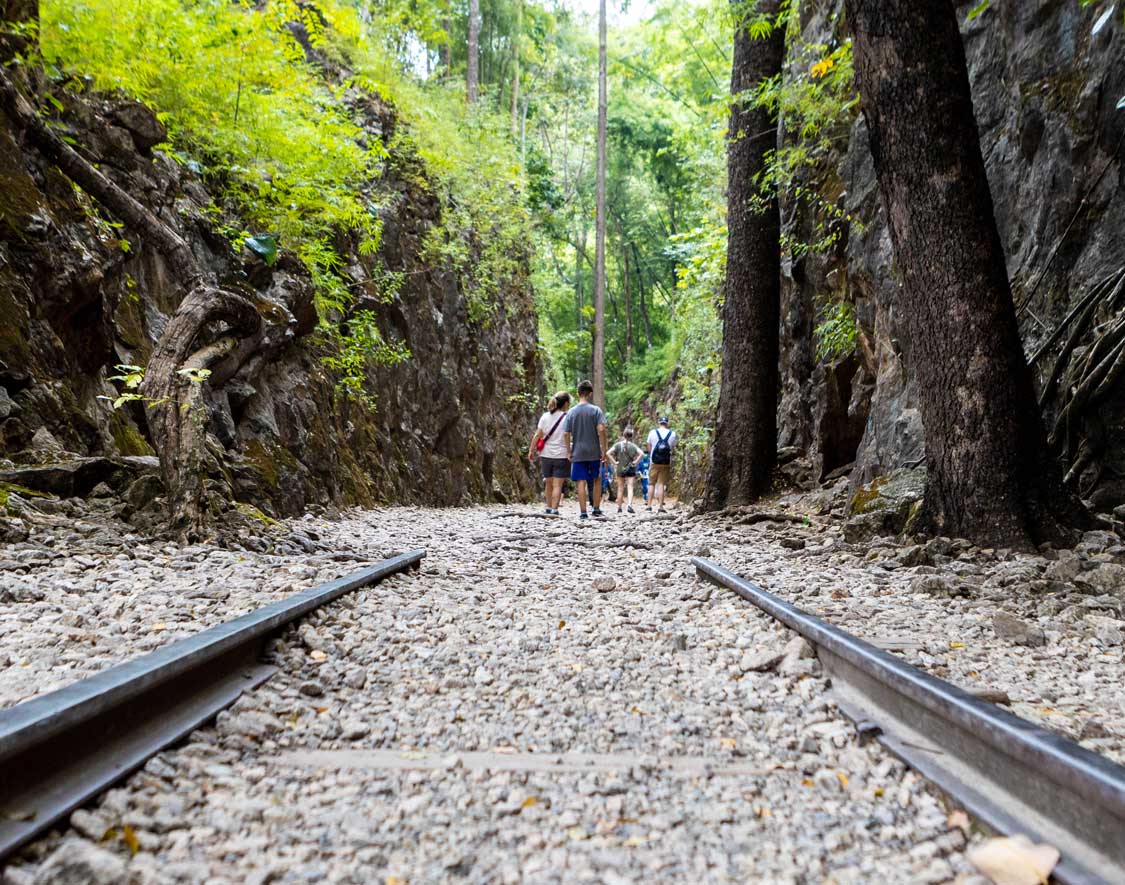
Hellfire Pass Memorial Museum and Interpretive Center is one of the best experiences in Kanchanaburi focused on the Death Railway. The museum and the associated trails is built at the location where the most deaths occurred while the railroad was under construction.
The museum includes testimonials from POWs who lived through the atrocities of the Thai-Burma Railroad construction and represents the countries that lost the most soldiers, including the British, Dutch, and Australians.
The museum, which was built by the Australian government, sits at the top of the canyon where Hellfire Pass was built. Visitors can walk miles of the former railway and see the incredible landscape through which it was built.
Apart from being incredibly historic and educational, Hellfire Pass is incredibly beautiful as well. It’s incredibly humbling and peaceful to walk through this storied pass. I recommend getting the audio guide from the museum. This allows you to hear the stories of Hellfire pass as you walk through it.
This tour includes both the River Kwai Bridge and Hellfire Pass as well as a ride on the Death Railway.
Ride the Death Railway
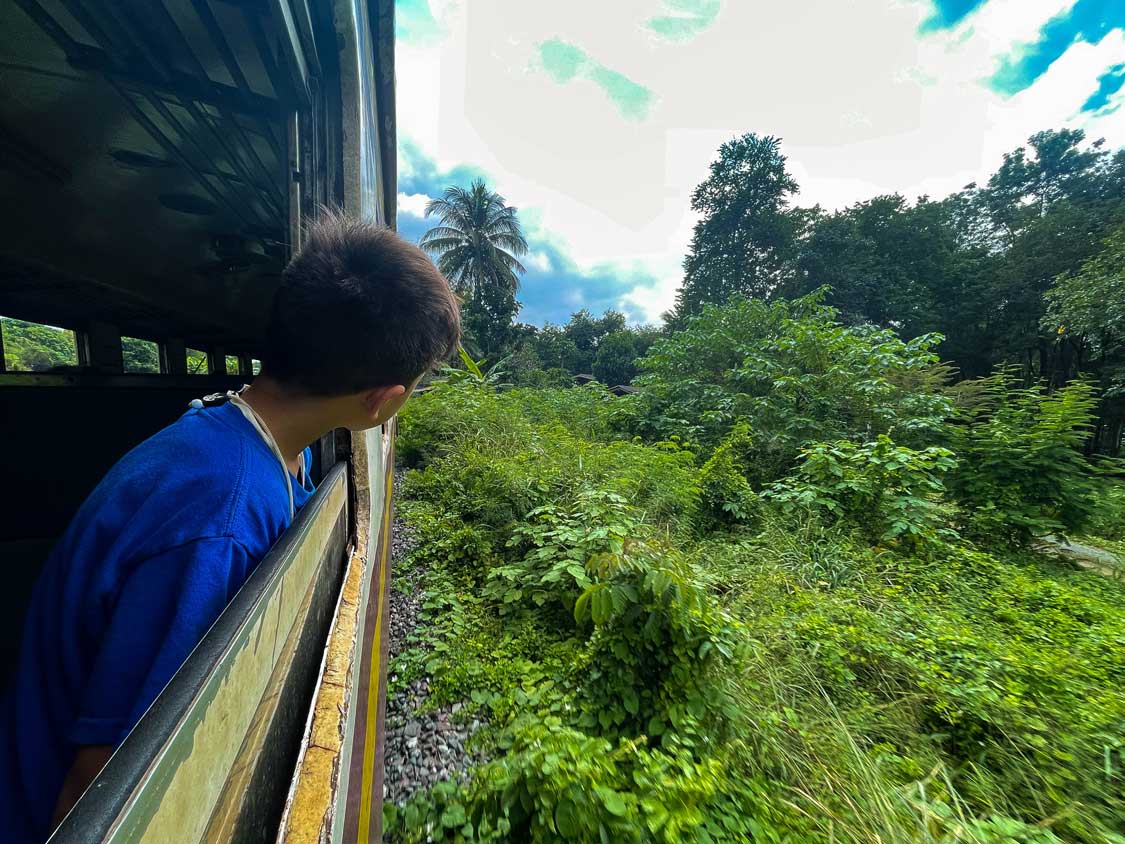
With all of the incredible Death Railway attractions in Kanchanaburi, Thailand, it would be a shame to visit and not take a ride on the Thai-Burma Railroad itself.
The 260-mile train route originally connected the city of Ban Pong in Thailand with the city of Thanbyuzayat in Myanmar(Burma). In 1947, the railroad was shut down, but sections of it reopened just ten years later.
Today, visitors and locals alike board the Death Railway to experience the majestic views of the route between the cities of Nam Tok and Kanchanaburi. The scenic, slow Kanchanaburi train ride glides through scenic farmland and along the edge of towering cliffs. Some of the most stunning stops include a bridge over the Khwae Yai River and tiny villages where travelers lean out the open windows to catch the perfect photograph.
The train picks up passengers along the way, so open seats can change. If you want the best views, I recommend getting a seat on the left side of the train. But there are a few places where the right side has some gorgeous scenery too.
A ride on the Death Railroad is one of the best things to do in Kanchanaburi. You can purchase your tickets at the Nam Tok or Kanchanaburi train station, or you can book a Death Railway tour ahead of time, which includes many of the other sites that I mentioned.
Sleep In A Floating Lodge
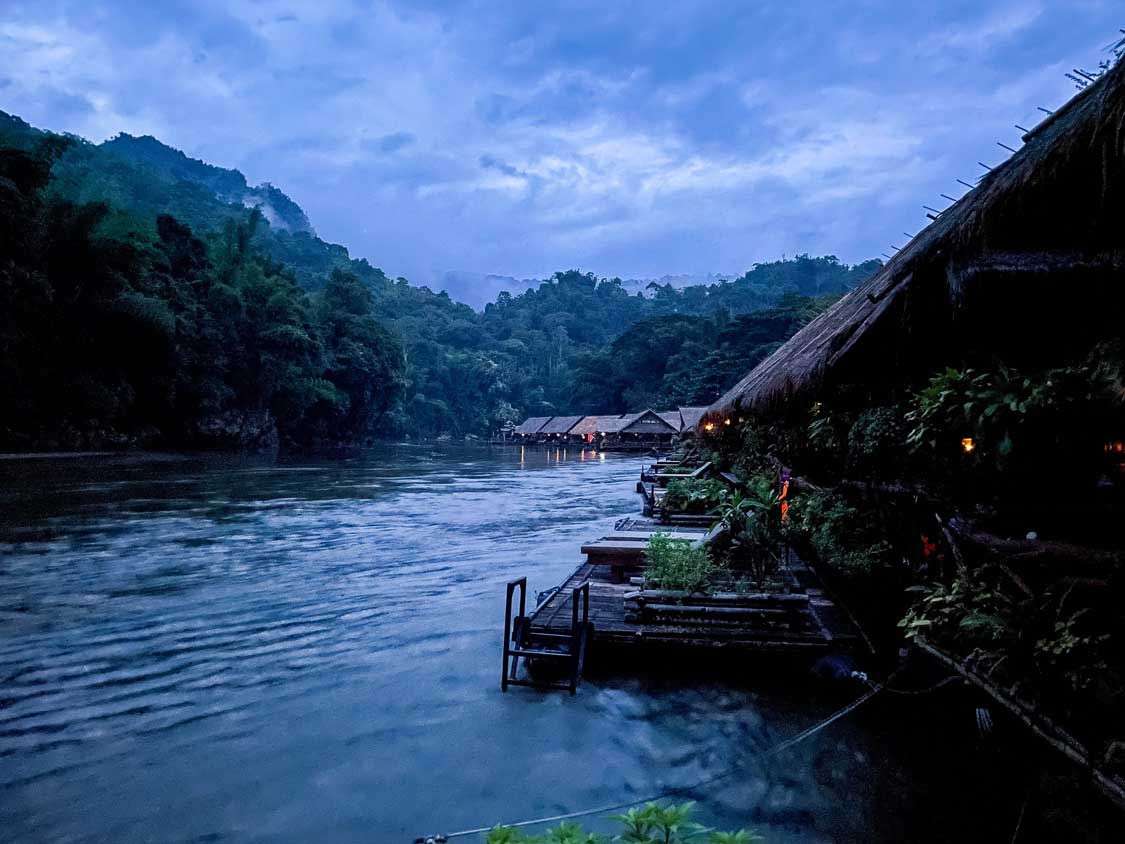
Our absolutely favorite thing to do in Kanchanaburi was our time at the Kwai River Jungle Rafts floating lodge in Sai Yok National Park.
There are several floating lodges along the Khwae Noi River, and they’re all pretty fantastic. We opted to stay at Kwai River Jungle Rafts, a gorgeous lodge just a short distance from Phutakein Pier. These amazing lodges are right on the water amidst the flowing currents.
Each room features a back deck looking out onto a Mon Hill tribe village, while the front connects all of the rooms and includes a lounging deck where our boys spent hours jumping into the fast-moving water and floating down to the lines of ladders in front of each room.
The floating lodges make for a great place to take day trips within Sai Yok National Park, including visits to Lawa Cave and Sai Yok Waterfall.
There is Mons village right behind the lodge where most of the staff live. Visits include a tour of the village, its Buddhist Temple, and a traditional Mons dance show. During our visit, we were lucky enough to be guided by the village school teacher who showed us how he is trying to keep the traditional Mons language alive among villagers and Mons people who have moved away to Thailand’s larger cities.
One thing concern I had with River Kwai Jungle Rafts was that the Mon Village still houses an elephant in their traditional practices. The elephant is no longer used for labor and is treated well by the villagers, although it is still ridden by its mahout. Thailand is in a unique transition time as it attempts to decommission and rehome former working elephants, and some villages, especially smaller, self-contained ones such as this, have yet to adjust completely.
If you want to see more from our stay at Kwai River Jungle Rafts, you can check out our YouTube video below. Don’t forget to like and subscribe! You can also read our complete review of this floating hotel here.
Tham Krasae (Krasae Cave)
The town of Lum Sum, which is one of the stops on the Death Railway, is one of the coolest places to visit in Kanchanaburi.
Tham Krasae is a massive limestone cave that draws hundreds of visitors thanks to the towering golden Buddha temple that adorns the inside. Those riding the train might have a few short moments to check it out, but a lengthy stop in Lum Sum isn’t guaranteed.
This isn’t the best Buddha temple in the region, but its unique position inside the cave makes it a pretty cool experience.
Sai Yok National Park
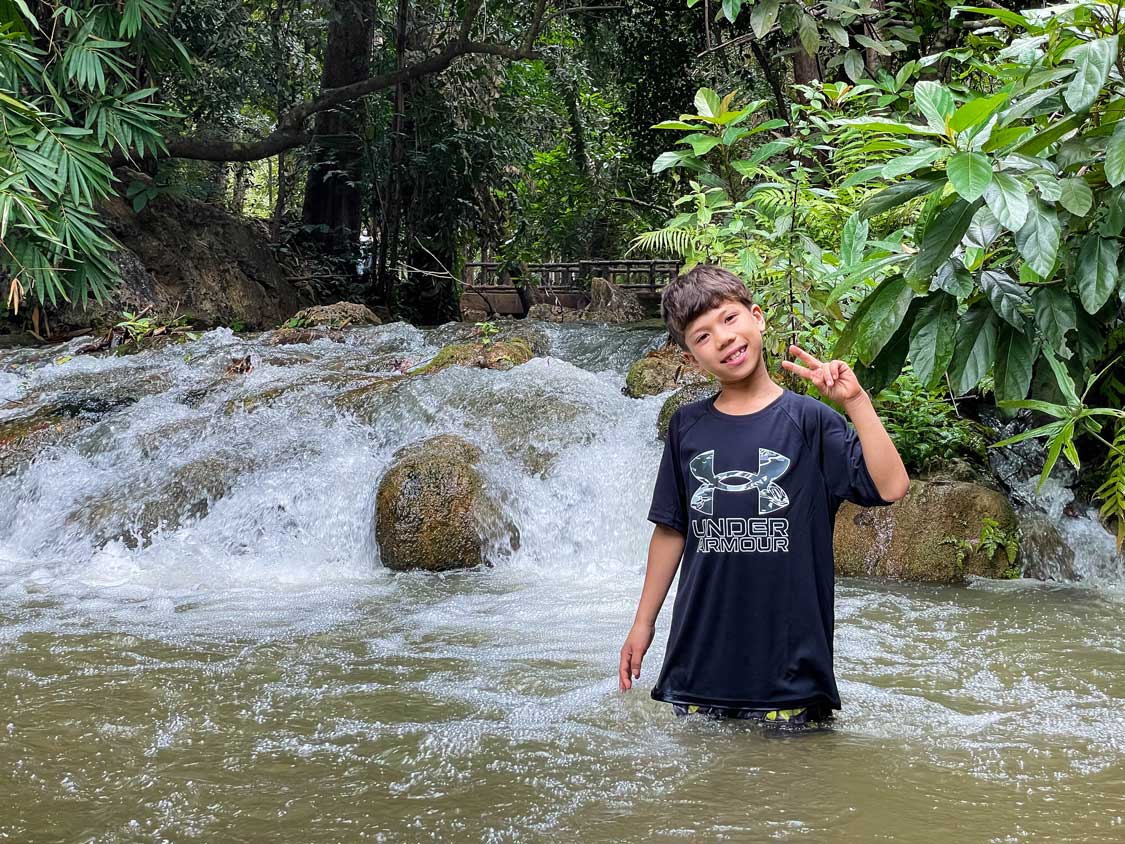
Sai Yok National Park should be on everyone’s list of places to visit in Kanchanaburi, Thailand. This incredible wilderness area is popular among both locals and tourists thanks to its impressive collection of caves and waterfalls.
The park is accessible by public transit, but most visitors either arrive by car or by longtail boat along the Khwae Noi River. These will all lead you to some of Sai Yok National Park’s most notable attractions, such as Khwae Noi River, Sai Yok Lek Waterfall, decommissioned sections of the Death Railway, Dao Wadung Cave, Khang Khao Cave, and Lawa Cave.
Our visit was by longtail boat along the Kwai River, where we stopped at Lawa Cave, which is situated just behind The Float House Lodge, which is a slightly more upscale floating lodge to River Kwai Jungle Rafts.
We’ve made no secret of our love of visiting caves with kids. The cave has a small temple inside and some stunning rock formations to explore. You’ll need a guided tour to access it, as it’s quite dark and slippery inside. You’ll also find a large colony of bats clinging to the roof of some of the rooms in the cave.
The most popular stop in the park is Sai Yok waterfall. This Kanchanaburi waterfall is located in the most developed area of the park. You’ll find a cafe, picnic area, docks for boats, and plenty of hiking trails here. You can follow the river leading to the waterfall up to where the water bubbles up from an underground stream.
Tham Than Lod National Park
Caves and waterfalls tend to be the biggest draws for tourism in Kanchanaburi, Thailand. Tham Than Lod National Park delivers these in spades.
Although Tham Than Lod is much less visited than Sai Yok or Erawan, this 33 sq. mile Thai national park still draws adventurers seeking pristine forests, incredible nature trails, and caves packed with stalactites and stalagmites. In fact, Than Lot Noi cave contains one of the world’s tallest natural pillars.
The main caves at the park are both show caves, so they are lit during the day. This means that you can leave the flashlights at home (unless you want to peak in some dark corners. Than Lot Noi cave also has a wooden boardwalk that runs through it, so it’s not very slippery.
The park offers camping, and there are a small cafe and toilet facilities available to visitors.
Erawan National Park
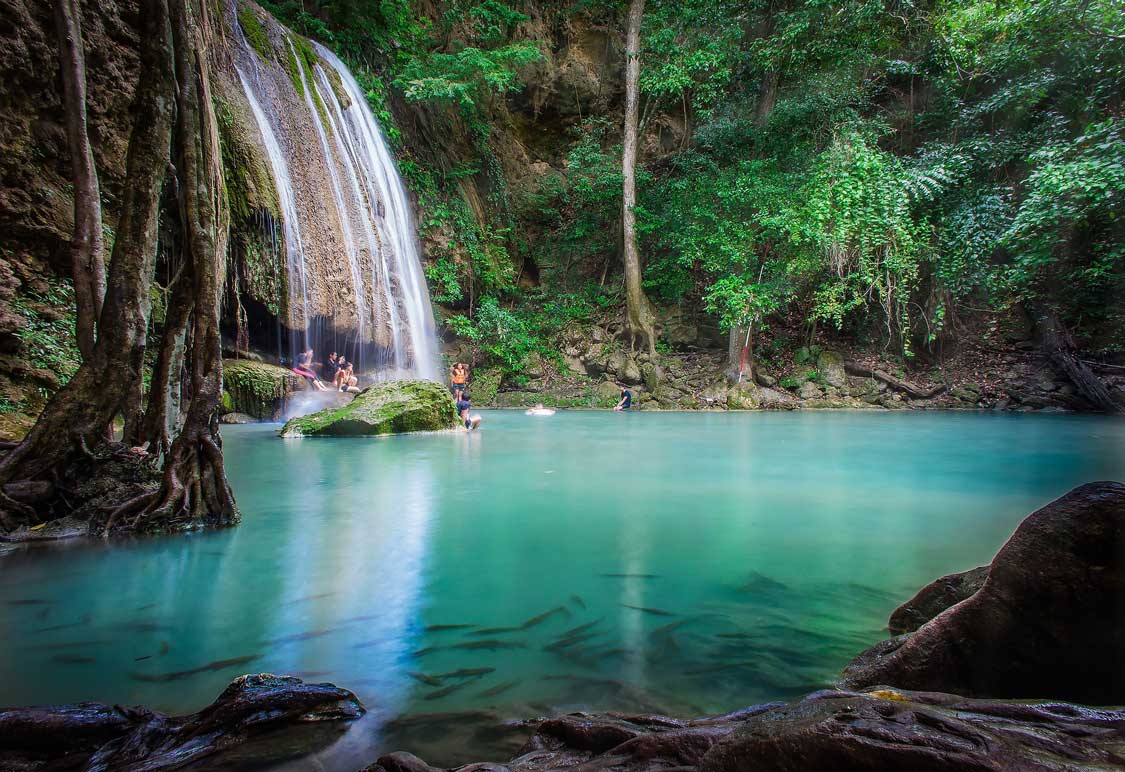
Situated in the Tenasserim Hills, a visit to Erawan National Park is one of the most popular things to do in Kanchanaburi. The park is home to one of Thailand’s most famous waterfalls, and the park was created in 1975 to ensure its conservation.
Erawan Falls flows over an eye-popping 7-tiers into a series of pools filled with emerald-green waters. Along with the beautiful waterfall, Erawan National Park also houses a series of long caves, some of which are located a short distance from the road, while others require a bit of a hike to reach them.
Erawan Falls was named after the three-headed white elephant in the Hindu religion, as the top section of the waterfall bears the resemblance to an elephant’s head.
This unique tour includes stops at Erawan Falls as well as Elephant Care, a hospice for sick and injured elephants.
Prasat Muang Singh Historical Park
Prasas Muang Singh Historical Park contains the ruins of the westernmost Khmer outpost in Thailand. The park protects the magnificent ruins of two Khmer temples that date back to the 13th and 14th centuries.
Among the attractions here are a preserved shrine, tower gates, and stone facades with ancient inscriptions. It’s believed that this was once a satellite city of the famous Angkor Wat in neighboring Cambodia.
Included in the entrance is access to a small museum where you can explore artifacts and relics from the site’s excavation.
Tips For Visiting Kanchanaburi, Thailand
How to Get to Kanchanaburi
The city of Kanchanaburi is located just 80 miles from Bangkok. However, the region covers a vast section of Western Thailand. You can get to Kanchanaburi by flight, bus, or train, or you can rent a car.
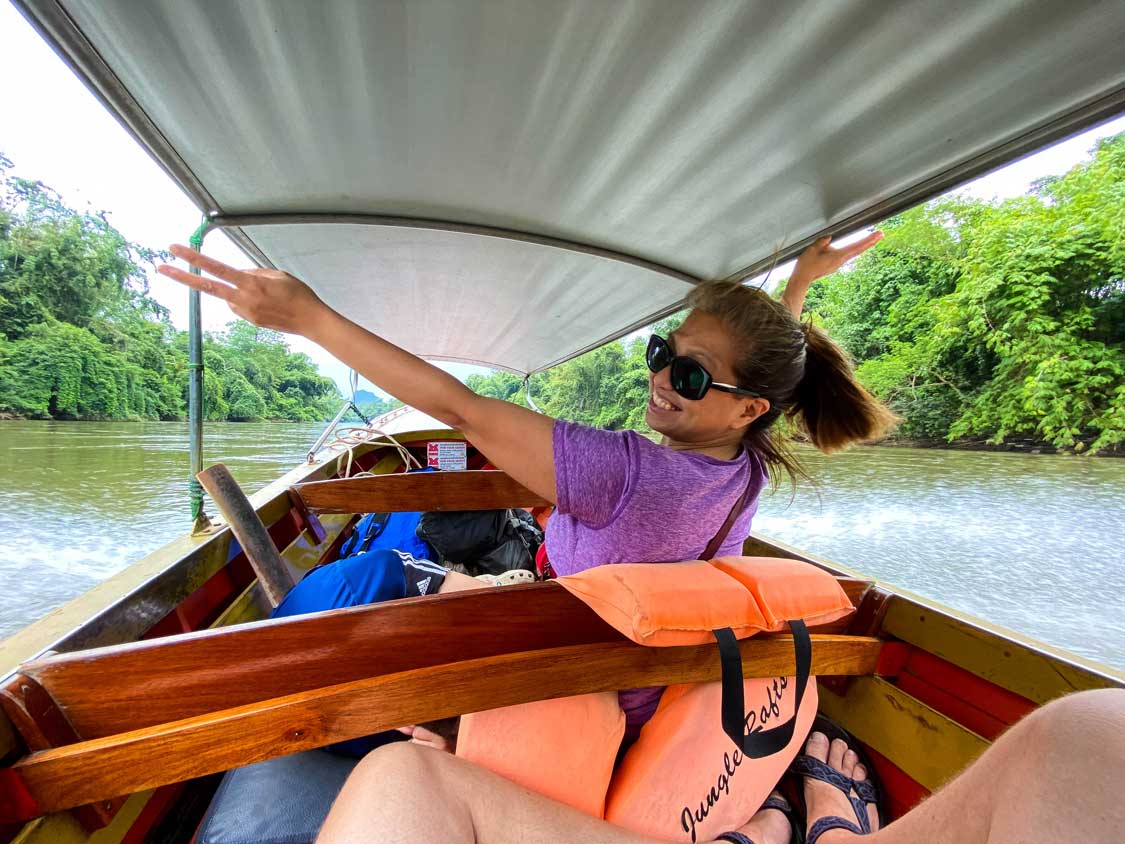
Flying to Kanchanaburi
The closest airport to Kanchanaburi is in Bangkok. The city has two major airports, both of which are easily accessible. Whether you’re coming from southern regions such as Krabi or Phuket or from northern cities such as Chiang Mai, traveling to Bangkok and then transiting to Kanchanaburi is your best bet.
Buses
If you’re traveling by bus through Thailand, there are quite a few connections through Kanchanaburi. Most of the top things to see in Kanchanaburi are accessible by bus either from Bangkok or from the city of Kanchanaburi itself.
Most travelers from Bangkok will travel from the Sai Tai Mai terminal in the south or the Morchit terminal in the north. The trip takes about 4 hours.
Trains
The most popular way to get to Kanchanaburi is by train. Thailand has an extensive rail network, and the Kanchanaburi by train will give you access to many areas from which you can then book a taxi, guided tour, or longtail boat.
Most trains to Kanchanaburi leave from Thonburi station in Bangkok and take between 3-4 hours. You can book different levels of comfort, I recommend booking an air-conditioned train car if you are traveling during the hot season.
Where To Stay In Kanchanaburi
If you have the time to stay for a few days in Kanchanaburi (and I highly recommend that you do), you’ll need a place to stay. There are some great accommodations in Kanchanaburi that will fit your travel style. Here are a few of my top recommendations.
Floating Lodges
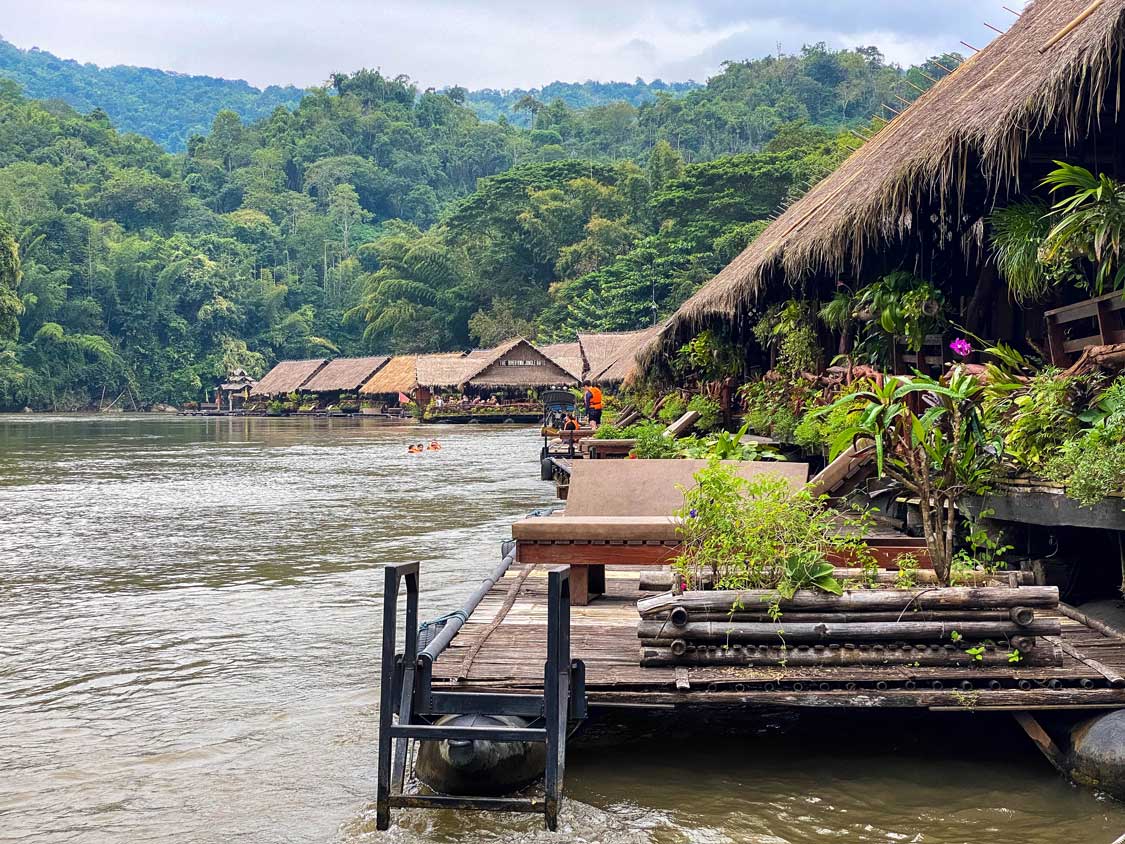
If you only choose one place to stay in Kanchanaburi, it should be in a floating lodge on the Kwae Noi River. These incredible Kanchanaburi river lodges give you access to Sai Yok National Park as well as some of the best things to do in Kanchanaburi.
The peaceful escape offers welcome relief from larger cities, and between the nearby Mons villages and park attractions, as well as dance shows and tours, you’ll have plenty to keep you occupied.
You can check out their prices and availability for The Float House here and for Kwai River Jungle Rafts here.
Natee The Riverfront Hotel Kanchanaburi
With a gorgeous outdoor pool that looks out over the Kwai River, Natee The Riverfront Hotel is one of the top places to stay in Kanchanaburi City.
The rooms at the resort are clean, modern, and stylish with easy access to the town and plenty of tours on offer to explore the Kanchanaburi attractions that are further afield. It’s within easy walking distance of the Kanchanaburi Rail Station.
You can check out their current rates and availability here.
Royal River River Kwai Resort & Spa
If you’re looking for a place to relax and unwind for a couple of days but don’t want to lose access to the internet through the floating lodges, the Royal River Kwai Resort might be your best option. It sits about 3.5 miles from the edge of Kanchanaburi. It’s close enough that you can access the best things to do in Kanchanaburi but far enough that you feel like you’re “getting away from it all.”
The hotel features polished, wood-paneled rooms with flat-screen TVs and private patios. There are two excellent restaurants on-site, one of which features a riverside terrace.
You can check out their rates and availability here.
Enjoy These Amazing Things To Do in Kanchanaburi, Thailand!
Thailand was a magical destination for family travel. Among all of the destinations, Kanchanaburi offered the easiest way to experience authentic life outside of the big city. From the magnificent national parks and spectacular floating lodges, these fun and exciting things to do in Kanchanaburi, Thailand, are sure to thrill every visitor.
If you love family travel as much as we do, please join our Family Travel Support Group on Facebook. You can connect with more family travelers just like you who love to explore the world.
You May Also Like To Read:

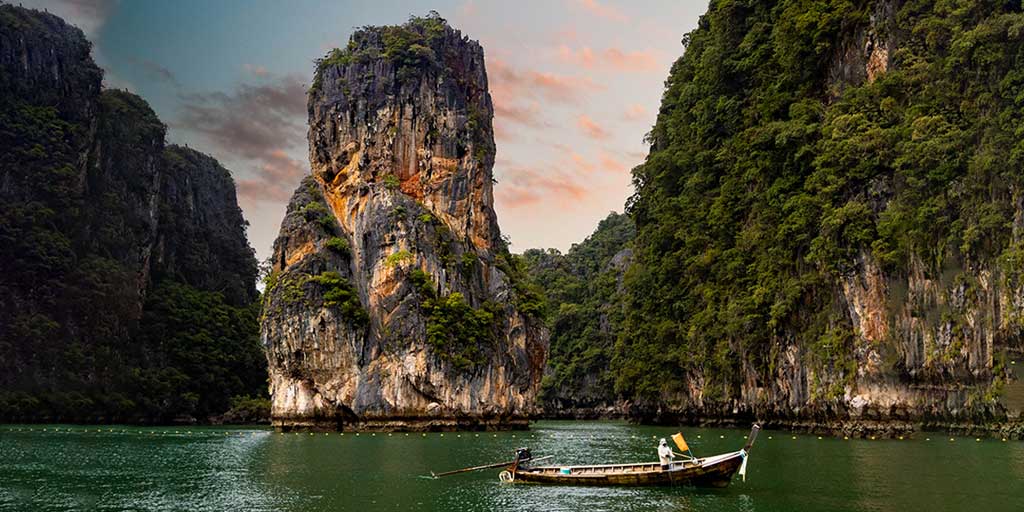
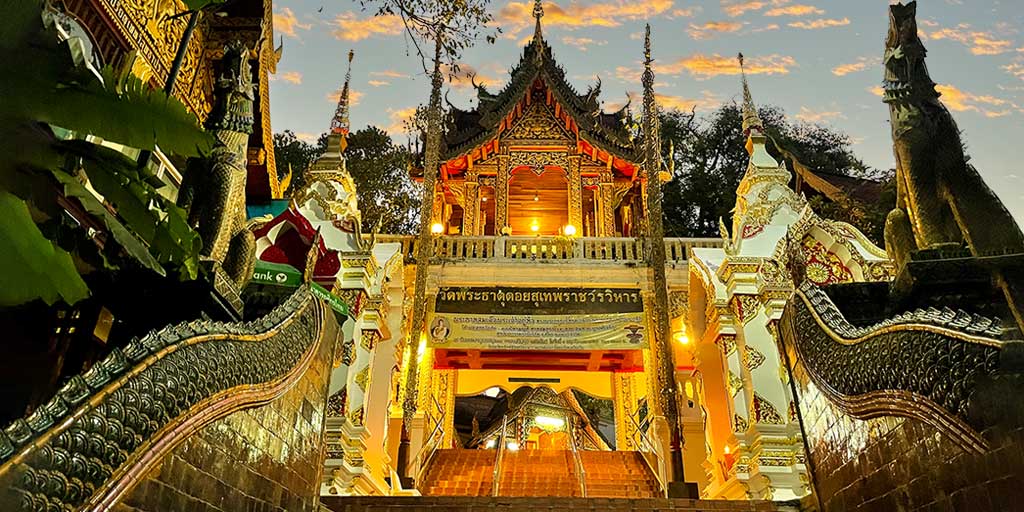
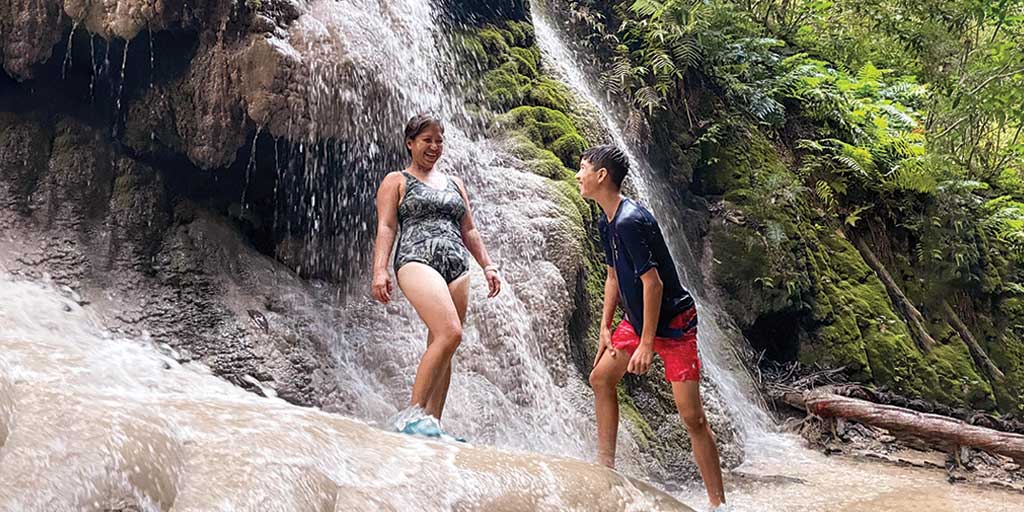
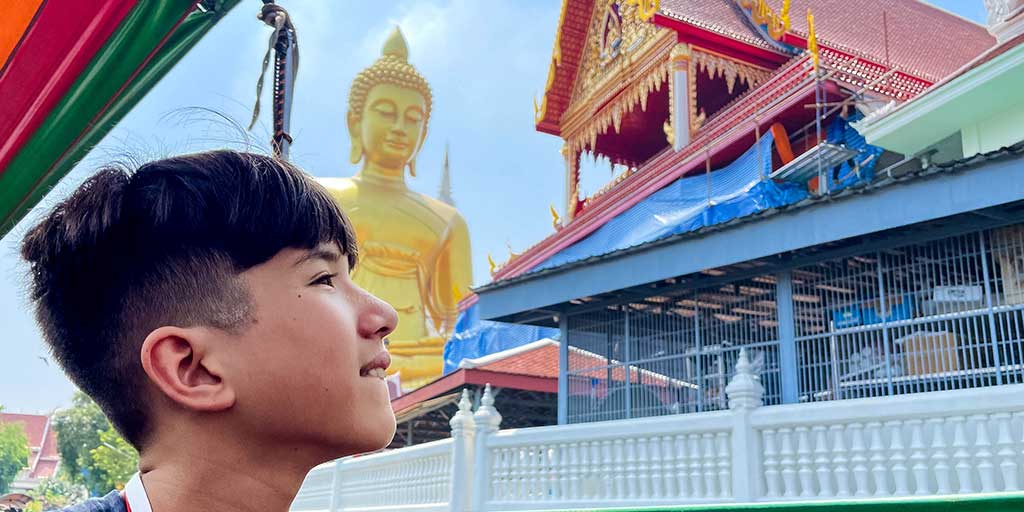
Merle Rosenstein
Saturday 2nd of November 2024
Hi Kevin, I enjoyed your Youtube video about your stay in Kanchanaburi. I'm planning a trip to Thailand for February and want to avoid over-touristed areas, but also want to see important sites. Any advice?
Kevin Wagar
Monday 4th of November 2024
Hi Merle,
Thanks so much, I'm happy to hear that you enjoyed the video! I've got great news for you. Kanchanaburi was one of the least touristy places that we visited in Thailand. I won't lie, the Bridge of the River Kwai was packed, along with the nearby markets. But the museums, river lodges, and even the National Parks were quite free of tourists (although you will find plenty of locals there enjoying their weekends away from the crowds).